Information injection-pump assembly
BOSCH
9 400 615 413
9400615413
ZEXEL
101606-0280
1016060280
ISUZU
8976019410
8976019410

Rating:
Service parts 101606-0280 INJECTION-PUMP ASSEMBLY:
1.
_
7.
COUPLING PLATE
8.
_
9.
_
11.
Nozzle and Holder
12.
Open Pre:MPa(Kqf/cm2)
16.2(165)/19.6(200)
14.
NOZZLE
Include in #1:
101606-0280
as INJECTION-PUMP ASSEMBLY
Include in #2:
104749-5450
as _
Cross reference number
BOSCH
9 400 615 413
9400615413
ZEXEL
101606-0280
1016060280
ISUZU
8976019410
8976019410
Zexel num
Bosch num
Firm num
Name
Calibration Data:
Adjustment conditions
Test oil
1404 Test oil ISO4113 or {SAEJ967d}
1404 Test oil ISO4113 or {SAEJ967d}
Test oil temperature
degC
40
40
45
Nozzle and nozzle holder
105780-8260
Nozzle
105780-0120
Bosch type code
1 688 901 990
Nozzle holder
105780-2190
Opening pressure
MPa
18
Opening pressure
kgf/cm2
184
Injection pipe
Outer diameter - inner diameter - length (mm) mm 6-2-600
Outer diameter - inner diameter - length (mm) mm 6-2-600
Overflow valve
131424-8620
Overflow valve opening pressure
kPa
206
172
240
Overflow valve opening pressure
kgf/cm2
2.1
1.75
2.45
Tester oil delivery pressure
kPa
255
255
255
Tester oil delivery pressure
kgf/cm2
2.6
2.6
2.6
Direction of rotation (viewed from drive side)
Left L
Left L
Injection timing adjustment
Direction of rotation (viewed from drive side)
Left L
Left L
Injection order
1-5-3-6-
2-4
Pre-stroke
mm
3.8
3.75
3.85
Rack position
Point A R=A
Point A R=A
Beginning of injection position
Governor side NO.1
Governor side NO.1
Difference between angles 1
Cal 1-5 deg. 60 59.5 60.5
Cal 1-5 deg. 60 59.5 60.5
Difference between angles 2
Cal 1-3 deg. 120 119.5 120.5
Cal 1-3 deg. 120 119.5 120.5
Difference between angles 3
Cal 1-6 deg. 180 179.5 180.5
Cal 1-6 deg. 180 179.5 180.5
Difference between angles 4
Cyl.1-2 deg. 240 239.5 240.5
Cyl.1-2 deg. 240 239.5 240.5
Difference between angles 5
Cal 1-4 deg. 300 299.5 300.5
Cal 1-4 deg. 300 299.5 300.5
Injection quantity adjustment
Adjusting point
-
Rack position
14.5
Pump speed
r/min
850
850
850
Average injection quantity
mm3/st.
133.5
131.9
135.1
Max. variation between cylinders
%
0
-2.5
2.5
Basic
*
Fixing the rack
*
Standard for adjustment of the maximum variation between cylinders
*
Injection quantity adjustment_02
Adjusting point
Z
Rack position
9.5+-0.5
Pump speed
r/min
300
300
300
Average injection quantity
mm3/st.
15.5
14.2
16.8
Max. variation between cylinders
%
0
-14
14
Fixing the rack
*
Standard for adjustment of the maximum variation between cylinders
*
Injection quantity adjustment_03
Adjusting point
A
Rack position
R1(14.5)
Pump speed
r/min
850
850
850
Average injection quantity
mm3/st.
133.5
132.5
134.5
Basic
*
Fixing the lever
*
Injection quantity adjustment_04
Adjusting point
B
Rack position
[R1+0.85
]+0.05-0
.15
Pump speed
r/min
1450
1450
1450
Average injection quantity
mm3/st.
127.5
124.3
130.7
Fixing the lever
*
Test data Ex:
Governor adjustment
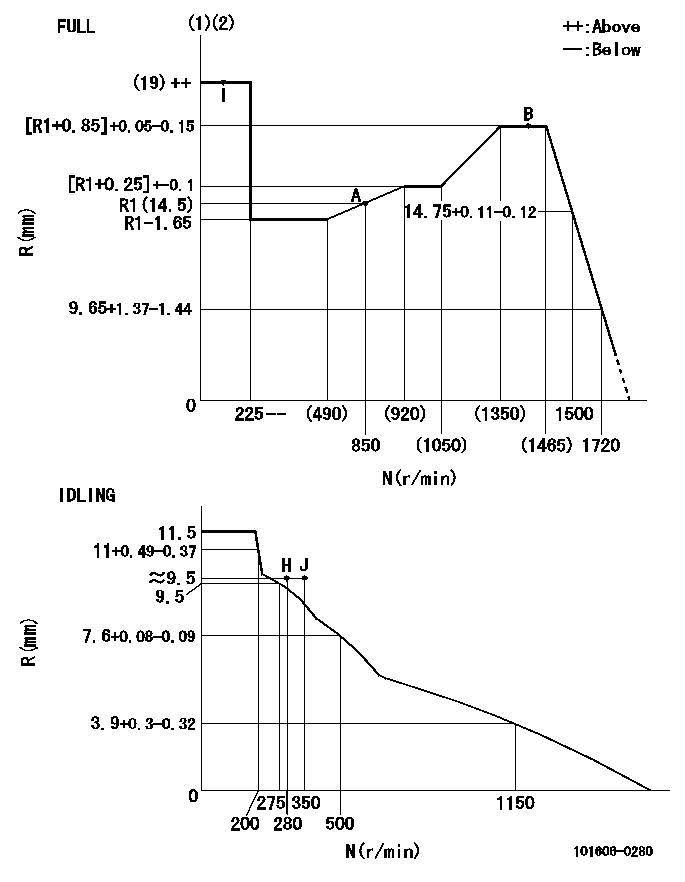
N:Pump speed
R:Rack position (mm)
(1)Torque cam stamping: T1
(2)Tolerance for racks not indicated: +-0.05mm.
----------
T1=P02
----------
----------
T1=P02
----------
Timer adjustment
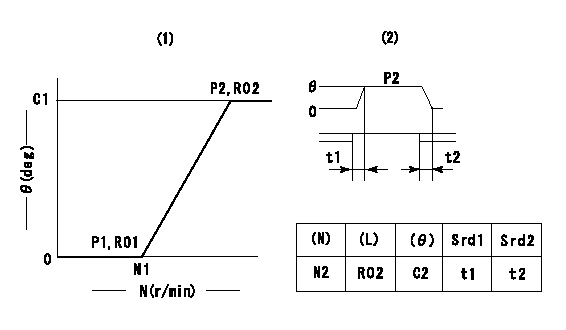
(1)Adjusting range
(2)Step response time
(N): Speed of the pump
(L): Load
(theta) Advance angle
(Srd1) Step response time 1
(Srd2) Step response time 2
1. Adjusting conditions for the variable timer
(1)Adjust the clearance between the pickup and the protrusion to L.
----------
L=1.5+-0.2mm N2=800r/min C2=(8)deg t1=2--sec. t2=2--sec.
----------
N1=1300++r/min P1=0kPa(0kgf/cm2) P2=392kPa(4kgf/cm2) C1=8+-0.3deg R01=0/4load R02=4/4load
----------
L=1.5+-0.2mm N2=800r/min C2=(8)deg t1=2--sec. t2=2--sec.
----------
N1=1300++r/min P1=0kPa(0kgf/cm2) P2=392kPa(4kgf/cm2) C1=8+-0.3deg R01=0/4load R02=4/4load
Speed control lever angle
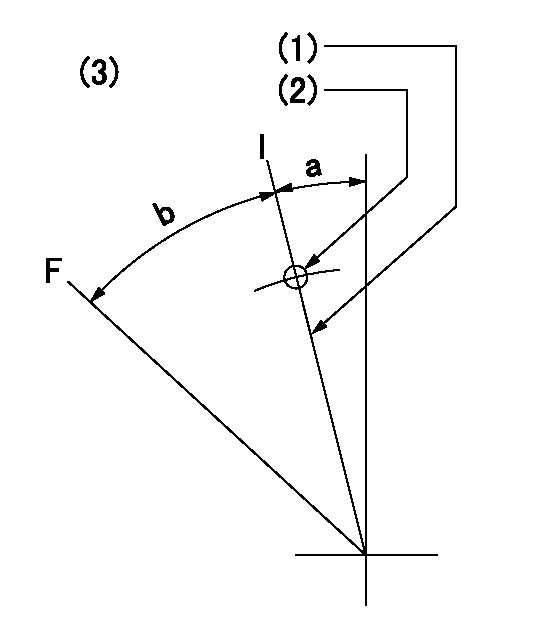
F:Full speed
I:Idle
(1)Stopper bolt setting
(2)Use the pin at R = aa
(3)Viewed from feed pump side.
----------
aa=35mm
----------
a=10deg+-5deg b=41deg+-3deg
----------
aa=35mm
----------
a=10deg+-5deg b=41deg+-3deg
Stop lever angle
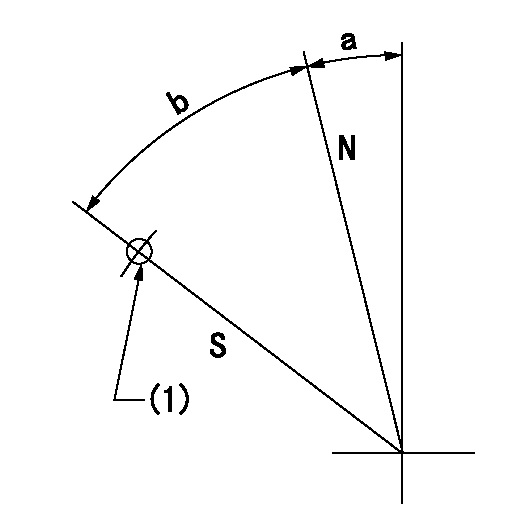
N:Pump normal
S:Stop the pump.
(1)Use the pin at R = aa
----------
aa=45mm
----------
a=12.5deg+-5deg b=40deg+-5deg
----------
aa=45mm
----------
a=12.5deg+-5deg b=40deg+-5deg
0000001501 RACK SENSOR
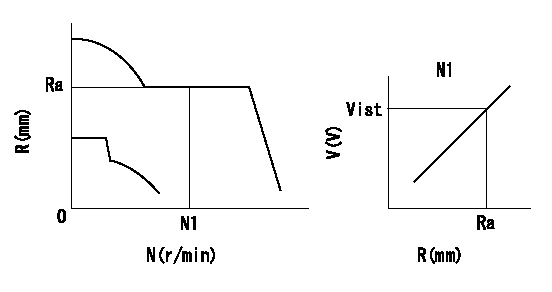
Rack sensor adjustment
1. Flange type rack sensor (rack sensor adjustment -5*20)
(1)These types of rack sensors do not need adjustment. Confirm the performance with the following procedures.
(2)Mount the rack sensor main body to the pump main body.
(3)Fix the pump lever at full.
(4)At supply voltage V1, pump speed N1 and rack position Ra, confirm that the amp's output voltage is Vist.
(5)Move the pump lever two or three times.
(6)Set again to full.
(7)Confirm that the amplifier output voltage is Vist.
(8)Fix the caution plate to the upper part of the rack sensor.
(For those without the caution plate instructions, make sure the nameplate of the rack sensor carries the "Don't hold here" caution.)
(9)Apply red paint to the rack sensor mounting bolts (2 places).
----------
V1=5+-0.01V N1=850r/min Ra=R1(14.5)mm Vist=3.74+-0.28V
----------
----------
V1=5+-0.01V N1=850r/min Ra=R1(14.5)mm Vist=3.74+-0.28V
----------
Timing setting
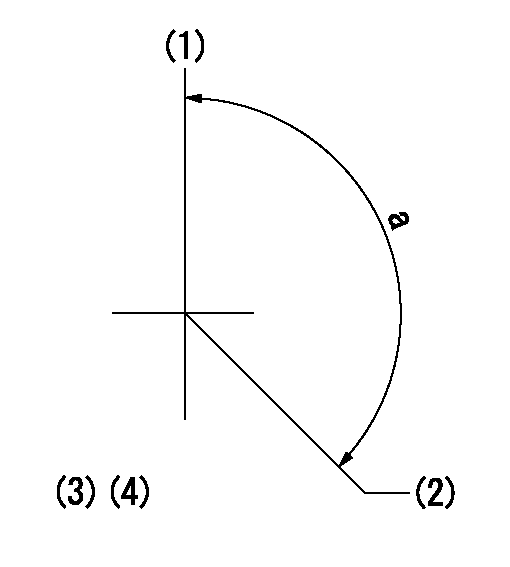
(1)Pump vertical direction
(2)Positions of coupling's threaded installation holes at No 1 cylinder's beginning of injection
(3)B.T.D.C.: aa
(4)-
----------
aa=6deg
----------
a=(160deg)
----------
aa=6deg
----------
a=(160deg)
Information:
Do not exceed 240°F (116°C) maximum engine oil temperature at any time.Do not exceed 2300 rpm in any situation. Overspeeding can result in serious damage to your engine.Operation of the engine over 2300 rpm will cause the Electronic system to activate the CHECK ENGINE lamp, indicating engine overspeed.
No special skills are required to operate a vehicle with a BrakeSaver. However, it requires the operator to observe the engine speed and the BrakeSaver oil temperature.
The BrakeSaver should not be used as a primary or service brake. The BrakeSaver is not an emergency or quick stop brake. Use the service brakes for quick stops.
The BrakeSaver provides auxiliary braking to slow the truck and to control speed on long grades. Governing the deceleration or downhill speed of a vehicle by using the BrakeSaver results in reduced wear on brake linings and brake drums. It helps save the service brakes for emergency stopping requirements.Braking effort is a direct function of engine speed. The greater the engine speed the greater the braking effort. This applies to all engines, especially those with slower speed economy ratings.The BrakeSaver utilizes the engine oil and cooling systems, which eliminates the need for auxiliary oil or cooling systems.Scheduled maintenance on the BrakeSaver, or additional engine maintenance, is not required.Trucks equipped with the BrakeSaver require an additional amount of engine lubricating oil. Refer to the Refill Capacities chart in this publication for proper amount of oil required for a BrakeSaver equipped engine.Manual Control
The hand-operated control lever is usually mounted on the steering column. It provides a smooth modulated application of the BrakeSaver for desired retarding of the vehicle up to 2300 engine rpm.This controlled modulation of the BrakeSaver is especially desirable on slippery roads. Increasing or decreasing the BrakeSaver action is accomplished by moving the control lever. Actuating the manual Brakesaver control will deactivate the Electronic engines' Cruise Control or PTO control.Automatic Control
The mode selector switch must be in the AUTOMATIC MANUAL position and the Electronic system Cruise Control ON/OFF switch must be in the OFF position for automatic control.In this mode, the BrakeSaver will automatically be applied when the clutch is engaged and the accelerator pedal is released.The BrakeSaver will automatically shut off when the clutch is disengaged or when the accelerator pedal is depressed. It will engage again when the clutch is re-engaged and the accelerator pedal is released.Gauges
The BrakeSaver CONTROL AIR PRESSURE gauge indicates the pressure at the BrakeSaver control valve. Air pressure should not exceed 50 psi (345 kPa).If the indicator shows reduced or no pressure, the BrakeSaver may not provide any braking effort. Stop the vehicle or operate at a reduced speed.Control vehicle stopping with proper downshifting and service brakes until proper repairs are made.The BrakeSaver oil temperature gauge indicator should register in the NORMAL (GREEN) range, 240°F (116°C). If the indicator moves to the RED range, move the BrakeSaver manual control lever to the OFF position.Operate the vehicle with the service brakes only, or stop the vehicle and let the engine idle until